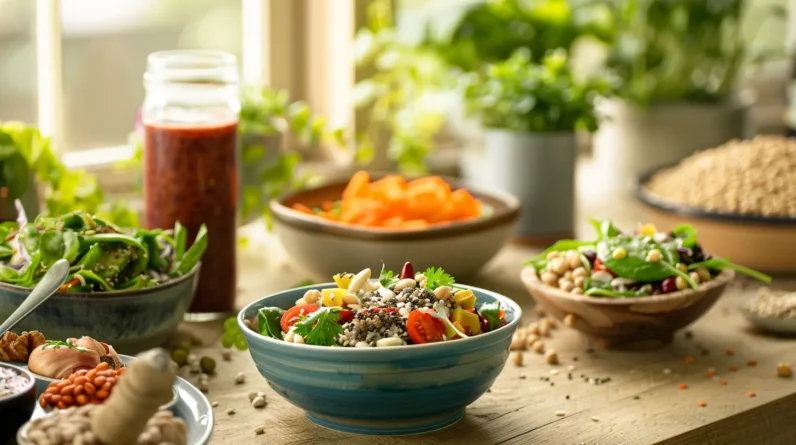
We recognize managing diabetes isn’t easy, but integrating healing nutrition can make a significant difference. To stabilize blood sugar, we recommend focusing on whole grains like quinoa and vegetables such as spinach, which are low in carbs and high in fiber. Proteins, including lentils and Greek yogurt, also play an essential role in maintaining steady glucose levels. Anti-inflammatory foods like salmon and berries can enhance insulin sensitivity and decrease inflammation, addressing diabetes-related complications. With balanced meals timed consistently, we can avoid sudden spikes in blood sugar. Let’s explore together how the right dietary choices can improve your health.
Understanding Carbohydrates and Diabetes
Understanding how carbohydrates impact blood sugar levels is essential for managing diabetes effectively. It’s evident that carbs directly influence glucose levels in our blood, prompting our bodies to produce insulin. This process is vital because for those living with diabetes, managing this balance is key to avoiding spikes and dips in blood sugar levels.
Carbohydrates aren’t just about sugars; they also include starches and fibers, which behave differently in our bodies. Simple sugars are absorbed quickly, causing rapid changes in blood sugar levels. Conversely, complex carbohydrates and fibers digest slower, resulting in a more gradual effect on blood glucose. We must comprehend these differences to tailor our dietary choices, ensuring stable blood sugar management and overall health improvement.
The Best Foods for Blood Sugar Control
Several foods are particularly effective in managing blood sugar levels, offering both nutritional value and stability for those with diabetes. Ideal choices include:
1. Whole grains like quinoa and oatmeal, slower to digest, preventing spikes in blood sugar.
2. Leafy greens such as spinach and kale, which are low in calories and carbohydrates.
3. Protein-rich foods like lentils and Greek yogurt, supporting steady blood glucose levels.
We’ve found that including these foods into your daily diet not only aids in blood sugar control but also enhances overall health.
It’s essential to balance these elements wisely, considering meal timing and portion sizes, to master diabetes management effectively. This approach empowers you to maintain stability in your blood sugar levels, essential for long-term health.
Benefits of Anti-Inflammatory Foods
Adding anti-inflammatory foods to your diet can greatly decrease inflammation, which is particularly advantageous for handling diabetes-related complications. Chronic inflammation often exacerbates diabetes and its associated conditions, such as cardiovascular diseases.
Research indicates that foods rich in omega-3 fatty acids, like salmon and flaxseeds, and those high in antioxidants, like berries and leafy greens, play an essential role in reducing inflammation markers. Scientific studies underscore that turmeric and ginger, known for their anti-inflammatory properties, can notably improve insulin sensitivity.
Planning Your Diabetes-Friendly Diet
Building on the benefits of anti-inflammatory foods, let’s explore how to structure a diabetes-friendly diet that supports your health goals. A well-planned diet is essential for managing blood sugar levels and reducing the risk of complications. Here’s what we need to focus on:
1. Balanced Meals: Include a variety of nutrients in every meal—proteins, fats, and carbohydrates— to help stabilize blood sugar levels.
2. Low Glycemic Index Foods: Opt for whole grains, legumes, and most fruits, as these have a slower impact on blood glucose.
3. Consistent Meal Timing: Eating at regular times helps prevent sudden spikes or drops in blood sugar.
Monitoring and Adjusting Your Diet
To effectively manage diabetes, it’s vital that we monitor and adjust our diet based on ongoing blood glucose readings and bodily responses. By keeping a detailed food diary and regularly reviewing it alongside glucose levels, we can identify patterns and pinpoint which foods spike blood sugar or cause undesired effects. This proactive approach allows us to make informed adjustments, ensuring our diet not only helps manage blood glucose but also supports overall well-being.
It’s essential we stay attuned to how different meals affect us personally, as individual responses can vary widely. Regular consultations with a dietitian can enhance this process, offering tailored advice based on our unique health profiles and nutritional needs. Together, we’ll refine our dietary strategy to best manage our diabetes.
Conclusion
As we navigate the waters of diabetes management together, it’s clear that the right foods are our best allies. By embracing a diet rich in anti-inflammatory ingredients and understanding our carb intake, we can keep our blood sugar levels steady.
Let’s continue to monitor and tweak our diets, ensuring they fit our unique needs. After all, there’s no one-size-fits-all solution, but with perseverance and knowledge, we can all find our path to better health.






